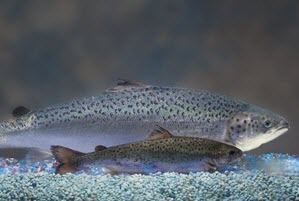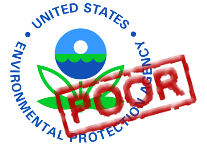The Food and Drug Administration has preliminarily determined that a genetically modified salmon developed by AquaBounty Technologies is safe for human consumption but many questions about the safety of GE salmon persist.
|
|
|||
|
In depth analysis of Judge White’s decision which rescinded USDA’s and APHIS’ decision to deregulate Roundup Ready sugar beets without conducting an Environmental Impact Statement. When Barak Obama was elected, many in the sustainability movement believed that they finally had an ally in the White House. However, the President’s agricultural appointments tell a different story. Ever since the Supreme Court handed down its mixed 7-1 decision, ruling that the lower court overstepped its boundary by issuing an injunction on the planting of genetically modified alfalfa, some lawmakers were spurred to action. A 13-state survey of honey bee pests and diseases that will help USDA scientists to determine the factors that may be contributing to the decline of honey bee colonies nationwide. Recent research from USDA points to a correlation between a fungus and a family of viruses that may be working together to cause the Colony Collapse Disorder in honeybees. Many still believe, however, that other causes such as pesticide use in agriculture and GMOs that produce pesticides, also play a role in the collapse. Last week, current and former chicken growers, mostly from the South, gave attorney general Eric Holder and USDA secretary Tom Vilsack accounts of a lack of competition, poverty-level earnings and bait-and-switch tactics among the big chicken producers. “This system takes hard working farmers and makes them indentured servants on their own land,” Kay Doby, a former chicken farmer from North Carolina, told a crowded room at Alabama A&M University. EPA has announced plans to place additional limitations on the use of three N-methyl carbamate pesticides – carbaryl, carbofuran and methomyl – to protect endangered and threatened salmon and steelhead in California, Idaho, Oregon and Washington, in compliance with the Endangered Species Act. The decision comes after manufacturers of the chemicals diazinon, malathion and chlorpyrifos refused to adopt the limits voluntarily. Ignoring criticis and finding their concerns to be “unlikely,” on May 12, 2010 APHIS approved for continued field tests the planting of experimental genetically modified eucalyptus trees across seven states. In December 2009, the USDA has released its draft environmental impact statement proposing to deregulate Monsanto’s genetically engineered alfalfa. GMO Journal submitted its public comment to the agency urging it to continue regulating GE alfalfa. There is still time to take action before the March 3, 2010 deadline. Do you part — tell USDA to reject Monsanto’s GE alfalfa. The United States Department of Agriculture (”USDA”) and its Animal and Plant Health Inspection Service (”APHIS), which oversees biotechnology regulation, was heavily criticized by its own Inspector General 2005 audit report. Did APHIS change its way since then? There is little doubt that Monsanto-farmer contracts are fundamentally unfair to the farmers. In this case, David does not fair well against Goliath. But are such agreements also fundamentally unfair to society because, unless you grow it yourself, what the farmer grows is what you eat. As a result of policies enumerated by the Coordinated Framework, regulatory control over GMOs in the United States was divided among different regulatory agencies. The consequences of such a decision was a myopic, and at times, haphazard regulatory control by each agency over GMOs. For USDA, this raises significant questions as to the agency’s ability to effectively regulate second generation GMOs. How can the public trust government agencies to ensure the safety of GMOs if those agencies have a long track record of failure? USDA’s regulatory track record begs the question of whether it is a government “regulatory” agency or an industry group. Industry bias, lax scientific standards, exemption of food crops containing pesticides from registration requirements, and failure to independently monitor GM crops after approval, are among the regulatory problems exhibited by the EPA when it comes to regulating GMOs. The United States government consistently promotes its regulatory framework for genetically engineered organisms as comprehensive and strict. Is this a public relations maneuver, wishful thinking or the story of the emperor without clothes? The USDA provides a number of exemptions for articles that it has determined do not pose a plant pest risk. One of such exemptions authorizes the introduction of certain regulated articles without a permit provided that USDA is notified in advance. The United States Department of Agriculture (”USDA” or “Agency”) requires that anyone desiring to import, transport interstate, or plant a regulated article must apply for a permit or make a notification to the Agency’s Animal and Plant Health Inspection Service (”APHIS”) that an introduction will be made. Under the Plant Protection Act (”PPA”) USDA requires that anyone desiring to import, transport interstate, or plant a “regulated article” must apply for a permit or make a notification to APHIS that an introduction will be made. The United States Department of Agriculture shares significant regulatory authority over GM crops with FDA and EPA. Transgenic, or genetically modified, plants are regulated by USDA’s Animal and Plant Health Inspection Service (”APHIS”) under the Plant Protection Act (”PPA”). The FDA’s regulatory approach thus focuses on the end product, rather than the process used to create genetically modified foods. In short, the FDA regards GM products as “generally regarded as safe,” (”GRAS”) and does not subject GM food products to food additive review. The Food and Drug Administration is the lead regulatory agency of food articles. It is in charge of ensuring the safety and effectiveness of food (other than meat), food additives, medical devices, drugs, veterinary drugs, cosmetics and genetically engineered food. TSCA provides the EPA with authority to regulate chemical substances which may present an unreasonable risk of injury to health or the environment during manufacture, processing, distribution in commerce, use, or disposal. TSCA applies to uses of substances that are not specifically covered by another statute, i.e., TSCA does not apply to pesticides, food, drugs or cosmetics. TSCA is therefore a “catch-all” or “gap-filler” statute. In the case of herbicide-tolerant crops, EPA establishes tolerances for the allowable amount of herbicide residues that may remain on the crop. |
|||
|
 |
|||












